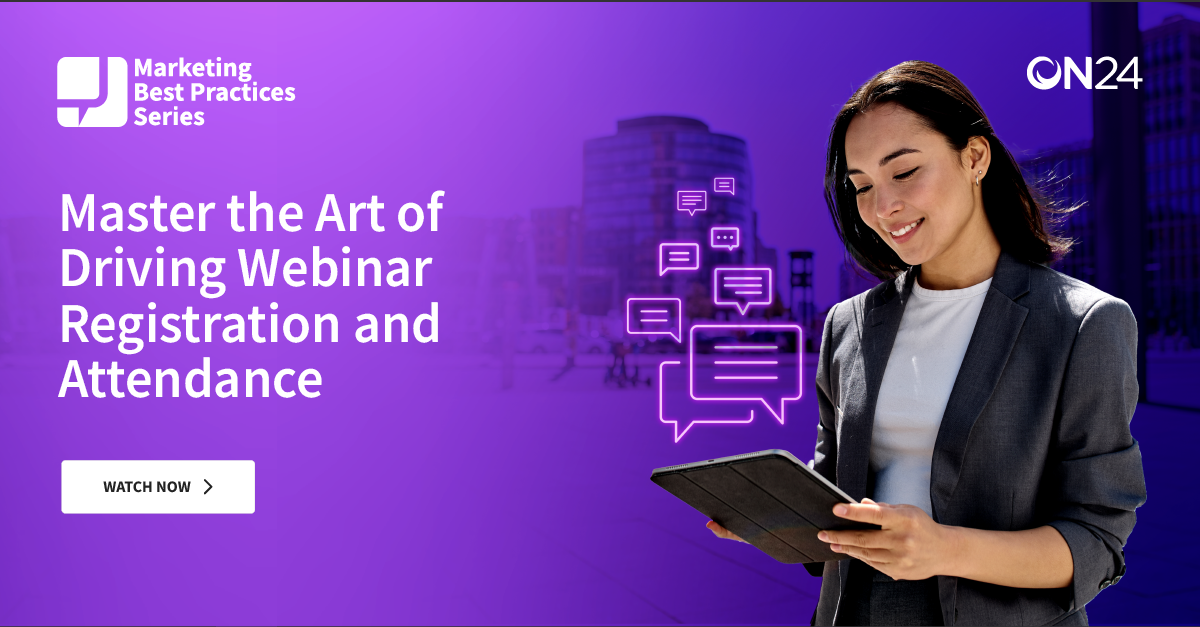How To Secure Sponsorship for Your Virtual Event

There are plenty of things to consider if you’re going all in on an upcoming event — especially if it’s digital. Top of the order: who can help? There are plenty of reasons to look outside your organization and secure sponsorships for your next big virtual event.
Obtaining sponsorships for virtual events creates tons of benefits for both parties. The sponsor can get extra exposure for their brand, plus the opportunity to speak directly to an audience with aligned wants and needs.
And, as the host, bringing a sponsor into the fold can help to strengthen your business relationship with that organization. You can also add a new dimension to your content strategy and raise money to help plan and execute a winning digital experience.
So, we know that getting sponsorships for virtual events can boost the credibility and reach of your event. But still, questions remain.
For example, how do you go about finding the right partner? Where are your potential sponsors likely to be? And how can you build an attractive sponsorship package that will make it difficult to say ‘no’ to your opportunity?
We’ll set about answering these questions and many more in this useful guide to finding and securing the right sponsor for your next virtual conference, symposium or big-ticket event.
Get Clarity on what you want to achieve from your event

You should always start by setting clear and realistic goals for your virtual experience. This is a crucial step in creating a virtual event sponsorship offering because the company you eventually partner with will need to share your vision and have similar objectives.
Think about:
What kind of event you’re going to produce
Are you plotting a full-scale conference, or would you instead host a more intimate affair with plenty of options for Q&As? Your future sponsor will want insights into your event format to see how many opportunities they will have to promote their brand and share their expertise. After all, sponsorships for virtual events are not a one-size-fits-all situation! Ideally, your sponsor should be well-suited to the format of your event.
What the key takeaway will be
Do you want to give your guests a greater understanding of your products and services, or are you looking for tangible leads? Either way, you’ll need to make sure your event sponsor is aware of what they and your audiences can expect to get from the session.
How you’re going to set your event apart from other webinars, simulives or livestreams on a similar topic
Your preferred sponsor may have already been approached by another host planning a presentation or seminar with a related theme. What can you offer that other event organizers can’t?
For example, can you include more in-app features on the day that help to engage attendees? Will your platform enable you to collect, analyze and share the behavioral data generated from the event to prove that you’ve achieved what you set out to do?
You may also find conducting a SWOT analysis of your virtual event program helpful. Assessing the strengths and weaknesses of your approach can help you determine which gaps need to be filled — and, crucially, which brands might be able to fill them for you.
Reach out to the brands that you believe are the best fit

Avoid a scattergun approach. Talking to companies that don’t align with your values or can’t enhance what you can offer will only waste your time (and theirs).
Instead, create a shortlist of between 5 and 10 brands that will align with your message, add value to your content, and be appreciated by your audience for their skills, experience, professional achievements or overall market presence. You must court these brands for a good sponsorship for your virtual event.
Remember: some of these brands may be existing customers or suppliers, while others may not know of you yet.
Utilize event sponsorship tools

You may already have a good idea of your dream sponsor. You could send tailored messages to every potential partner — and there’s no harm in taking this more personalized route to start the conversation — but you can speed up the pitch process with a few tools like SponsorPitch and SponsorMyEvent.
These apps can often provide information on the other partnerships your potential sponsors are engaged in. If you don’t want to be linked with a particular brand, even at the second degree, you can immediately cross that company off your list.
Get On A Call

Email communications can work — but for the best results, get in front of your potential virtual event sponsor to run the opportunity past them in full. During the call, you’ll need to discuss:
-
- What will your agenda entail
- Which other companies or brands are involved (if this applies)
- What your sponsor’s goals might be for the partnership
- What your sponsor can expect to gain from the event – but make it clear that you’ll be open to ideas and negotiations as planning unfolds
- What you’re expecting from your sponsors in return for the exposure
- Which KPIs you both want to use to measure event success
- Any challenges your potential sponsor has faced in the past when supporting similar events – and how you will combat them
Get your prospective sponsor excited about the opportunity by encouraging an open, two-way discussion that focuses on the benefits of sponsoring your virtual event — not just what the event itself will look like.
Make sure you save enough time to answer questions and get the prospect’s feedback on your virtual event sponsorship ideas. You might even want to research your decision-maker online before the call so you can get a feel for their personality and their experience with sponsorship schemes to date.
If it’s a “no for now,” it’s onto the next.
Decide how to integrate your sponsors into your virtual event

You’ve hooked your event sponsor, and it’s time to assemble an irresistible sponsorship package.
Ultimately, your sponsors want value. Regarding sponsorships for virtual events, you must ensure they get what they need from your partnership. Generally, brands will want to achieve three things from your event:·
-
- Greater brand awareness
- Actionable audience insights
- Better audience engagement
Once you’ve determined which of these goals is most important to your partner, put some options in an official sponsorship proposal, which should also contain information on your audience demographics.
In this proposal, you should include how many people you expect to attend the event, testimonials from past sponsors, and any statistics on the returns past sponsors have received from your events.
25 Creative virtual event sponsorship ideas
Need some inspiration? You could ask your sponsor to:
-
- Host a keynote talk or presentation
- Run a seminar
- Take part in an interview
- Take part in a Q&A round
- Host an in-event or pre-event seminar
- Promote your event in email newsletters or across their social media accounts
- Film promotional or behind-the-scenes videos in the run-up to the event to generate further interest and encourage sign-ups
Create a dedicated landing page or blog post on your website to help promote your sponsor’s brand
-
- Include tailored, branded content from your sponsor in your event’s content hub
- Include your sponsor’s branding in your virtual event’s template
- Run an exclusive special offer for attendees on your sponsor’s behalf
- Agree to send a list of all registrants and attendees to your sponsor after the event
- Agree to send on further insights into how attendees reacted to the event
- Set up a branded virtual booth for attendee engagement.
- Host a branded networking lounge for informal attendee interaction.
- Sponsor focused breakout sessions on niche topics.
- Offer branded virtual backgrounds or filters for attendees.
- Provide exclusive downloadable content (eBooks, white papers).
- Run a sponsor-hosted contest or giveaway during the event.
- Send push notifications to attendees with special offers or updates.
- Organize a social media challenge with branded prizes.
- Sponsor interactive polls or surveys to engage attendees.
- Brand on-demand event content post-event with sponsor ads.
- Offer exclusive VIP sessions or meet-and-greets hosted by sponsors.
- Send virtual or physical swag bags with branded sponsor items.
One of the best ways to get a sponsor for an event is to provide a series of tiered packages for them to choose from. For example, you can create Bronze, Silver and Gold proposals with features and benefits at different price points. This should allow a wide range of brands to meet their specific goals when it comes to sponsoring your virtual event. Here is a brief example of tiered sponsorship packages that could be used:
Gold Sponsorship Package
Your Gold sponsorship package should provide the most prominent visibility and engagement opportunities. Sponsors at this level are typically looking for prime real estate in terms of branding and interaction with attendees. Some features to include in a Gold package could be:
-
- Exclusive branding in high-traffic areas of the event platform, such as the main stage, virtual lobby, or attendee email communications.
- Speaking opportunities, like keynote sessions or participation in panel discussions, allowing sponsors to position themselves as thought leaders.
- Sponsored content sessions, where sponsors can host workshops or product demos that engage directly with the audience.
- Custom post-event reports, offering detailed analytics on attendee engagement, content interaction, and lead generation.
Silver Sponsorship Package: High Value, Strategic Placement
Your Silver package offers a balanced combination of visibility and engagement at a more accessible price point. Sponsors in this tier can expect solid exposure, though not as prominent as Gold-level sponsors. Key elements might include:
-
- Branding in breakout sessions or workshops, ensuring the sponsor’s presence is felt in key engagement moments.
- Inclusion in sponsored polls or Q&A sessions, which allows sponsors to engage directly with participants during live segments.
- Logo placement on session intros, virtual signage, and post-event materials, keeping the sponsor visible throughout the attendee journey.
- Moderate analytics reports that highlight how their brand performed across various touchpoints during the event.
Bronze Sponsorship Package: Cost-Effective, Targeted Visibility
For organizations with smaller budgets or those just dipping their toes into virtual event sponsorship, a Bronze package offers targeted, yet impactful opportunities for brand exposure. This tier can include:
-
- Logo placement on pre-event marketing materials, such as emails or event registration pages.
- Sponsored mentions during key event moments, such as before and after popular sessions.
- Access to post-event attendee lists with basic engagement metrics, so sponsors can follow up with warm leads.
- Inclusion in virtual booths or exhibit spaces, where attendees can access sponsor content, book meetings, or request demos.
How to measure ROI for virtual event sponsors
For sponsors, it’s not just about visibility—it’s about tangible results. Measuring the return on investment (ROI) for virtual event sponsors is crucial in demonstrating value and ensuring long-term partnerships. By providing clear, data-driven insights, you can show sponsors exactly how their investment contributed to their marketing and business goals.
Here are the key metrics that matter when it comes to proving ROI for your sponsors:
Attendee Engagement
One of the most critical metrics is engagement—the extent to which attendees interact with sponsor content. This includes the number of attendees visiting sponsored booths, clicking on sponsor logos, or attending sponsor-led sessions. Engagement metrics provide sponsors with a clear picture of how effectively they captured attendee attention. Specific engagement data might include:
-
- Booth visits: How many attendees visited the sponsor’s virtual booth and engaged with content or live reps.
- Session attendance: The number of attendees who joined a sponsor’s session, whether it was a keynote, breakout, or demo.
- Interactive features: Engagement with polls, Q&A sessions, or live chats hosted by the sponsor.
Lead Generation
Lead quality is often a key driver for sponsors. Metrics like the number of qualified leads gathered during the event can make or break a sponsor’s perception of ROI. This includes:
-
- Number of leads collected: Attendees who opted to share their contact information or requested further information about the sponsor’s offerings.
- Lead qualification: Segment leads based on their level of interest or engagement with the sponsor’s content (e.g., high-intent leads who attended multiple sessions or downloaded content).
Brand Visibility
Sponsors often aim to increase brand awareness, and virtual events provide multiple touchpoints for exposure. Tracking metrics around visibility helps sponsors understand how frequently their brand was seen by the audience. This includes:
-
- Impressions: The number of times the sponsor’s logo or brand materials were displayed throughout the event—on session intros, virtual booths, or in promotional emails.
- Social media mentions: Measure how often the sponsor was mentioned on social media or featured in event-related posts.
Content Consumption
Sponsors who provide downloadable content, such as white papers or case studies, will want to know how their resources performed. Metrics that show how attendees interacted with sponsor content are crucial for proving value. Track:
-
- Content downloads: How many attendees downloaded the sponsor’s resources.
- Video views: If the sponsor provided video content, track how many views and how much time was spent watching.
Post-Event Analytics
Virtual events provide a treasure trove of post-event data that can help sponsors measure the long-term impact of their sponsorship. After the event, share detailed analytics with your sponsors, such as:
-
- Post-event traffic: How much traffic the sponsor’s website received as a direct result of the event.
- Engagement with on-demand content: Sponsors can continue to benefit from their participation if the event content remains available on-demand. Ensure that you track how many attendees view sponsor-related sessions after the event has ended.
The tips listed here should help you save valuable time and resources when it comes to finding sponsorships for virtual events, not to mention help you create long-lasting relationships with the brands that matter to your organization. For more best practice guides, marketing playbooks and customer case studies, check out our resources.

